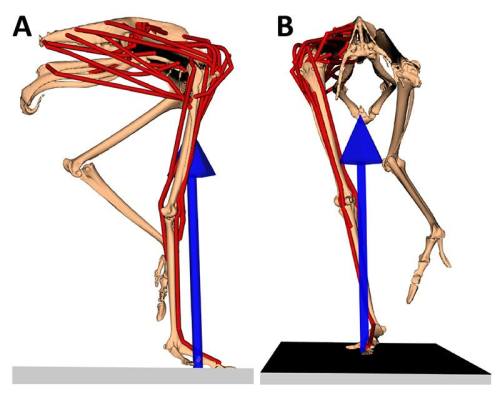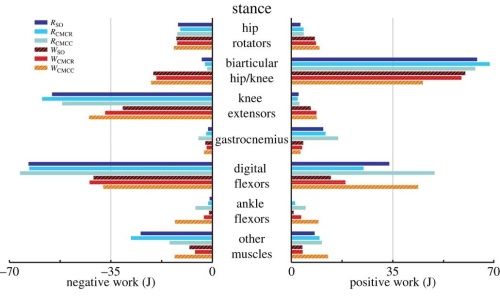Last year we finally, after about 14 years of slow work, released our biomechanical model of an ostrich’s hindleg. We showed how it informed us about the potential leverages (moment arms; contributions to mechanical advantage of the joints) of all of the muscles. It was a satisfying moment, to understate it, to finally publish this work from my postdoc at Stanford. Today, we begin to deliver on that model’s promise. And it only took 4 years or so, roughly? The journal Royal Society Interface has published our study of how we used this musculoskeletal model to simulate walking and running dynamics. Those simulations join an intimidatingly broad and complex literature using similar models to study human (and some other primate) locomotion or other functions at the level of individual muscles (for whole limbs/bodies) in vast detail and growing rigor. I have Dr. Jeffery Rankin, a research fellow finishing up his post with me after ~6 years of hard work on many projects, to thank for driving this work forward, and Dr. Jonas Rubenson (now at PennState) for his patient collaboration that has continued since the early 2000’s.
Stomach-Churning Rating: 2/10; computer models of muscle actions. The underlying anatomical data are goopy, as prior ostrich-dissection-focused posts show!

Our model; in right side view (on the left) and frontal view (on the right), with muscles in red and the leg’s force as the blue arrow; frozen at the middle of a running step.
Simulations like these predict things that we can’t easily measure in living animals, such as how much force muscles and tendons generate, how quickly those tissues change length, how much mechanical energy they thus contribute to the joints, limbs and whole body, how much metabolic energy their actions cost, and much more. There are more ways to use these tools than I have space or time to explain, but simply put we forced our ostrich simulation to match experimental measurements of the motions and forces of a representative walking and running ostrich stride, from contact of one foot until the next time that foot hit the ground. It then used optimization methods (minimizing target criteria like muscle stress) to estimate how the muscles and tendons were used to generate those motions and forces. This is a ways ahead of some prior ostrich simulations such as this one that I recall from classes during my PhD studies.
Any modeller worth their salt knows that their models and simulations are wrong at some level. This is much as most science is “wrong”; i.e. a simplification of reality with some errors/noise introduced by assumptions, variation, methods and such. But generally these kinds of musculoskeletal dynamic simulations hold up pretty well against experimental data. A standard “validation” is to test how closely the simulations’ predictions of muscle activity match the “real” (measured in life, also with some uncertain error) activity of muscles. Science still lacks those data for ostriches, but fortunately measurements from other birds (by Steve Gatesy and colleagues) indicate that muscles tend to follow fairly conservative patterns. Grossly speaking, avian leg muscles tend to either be active mainly when the foot is on the ground (stance phase) or off the ground (swing phase). Some studies acknowledge that this is an oversimplification and other muscles do act across those two phases of a stride, either in multiple pulses or as “transitional” (stance-to-swing or swing-to-stance) switch-hitters in their activations. Our ostrich predictions matched the qualitative patterns for avian muscle activations measured to date, so that’s good. The results also reinforced the notion of transitional or multi-phasic muscle activation as still having some importance, which bears more study.
Yet what did the simulations with our ostrich model tell us that other ostrich experiments or other bird species didn’t? Three main things. First, we could calculate what the primary functions of muscles were; they can act as motors (generating energy), brakes (absorbing energy), springs (bouncing energy back and forth) or struts (just transmitting force). We could then sum up what whole muscle groups were doing overall. The image below shows how these broad functions of groups vary across the stance phase (swing phase is harder to condense here so I’ve left it out).

Positive work can speed things up; negative work can slow things down. Solid bars are running; striped bars are walking. (from our Fig. 13) You may need to click to em-broaden this image for the gory biomechanical details.
There’s a lot going on there but a few highlights from that plot are that the hip extensor (antigravity) muscles (biarticular hip/knee “hamstrings”) are acting like motors, the knee extensors (like our quadriceps) are mainly braking as in other animals and the ankle is fairly springy as its tendons (e.g. digital flexors; gastrocnemius) suggest. We often characterize birds as “knee-driven” but it’s more accurate biomechanically to say that their hips drive (power; i.e. act as motors) their motion, whereas their knees still act as brakes — in both cases as in many other land vertebrates. Thus in some ways bird legs don’t work so unusually. Birds like ostriches are, though, a little odd in how much they rely on their hamstring muscles to power locomotion (at the hip) rather than their caudofemoral muscles, which are reduced. Zooming in on some particular muscles such as parts of the hip or knee extensors, the functions sometimes weren’t as predictable as their similar anatomy might suggest. Some muscles had parts that turned on during swing phase and other parts used during stance phase. Neural control and mechanics can produce some unexpected patterns.
Second, we looked at one important methodological issue. Simulations of musculoskeletal dynamics can vary from simple static (assuming each instant of a motion is independent from the others; e.g. ignoring acceleration, inertia, tendon effects, etc.) to more complex grades of fully dynamic flavours (e.g. assuming rigid or flexible tendons). We looked across this spectrum of assumptions, for both walking and running gaits, with the expectation that more static assumptions would work less well (vs. more dynamic ones; by various criteria) for running vs. walking. This also showed us how much tendons influence our simulations’ estimates of muscle mechanics—a fully rigid tendon will make the muscle do all of the work (force times length change) whereas a flexible tendon can literally take up some (or even all) of that slack, allowing muscles to remain closer to their isometric (high force-generating, negligible length change) quasi-optimum.
Nicely, our predicted muscle functions weren’t influenced much by these methodological variations. However, static assumptions clearly were in some ways less appropriate for running than for walking, as were flexible tendons. Somewhat surprisingly, making the simulations more dynamic didn’t lower the levels of activation (and thus presumably the metabolic costs) of muscles, but actually raised those levels. There are good reasons why this might be realistic but it needs further study. It does muddy the waters for the issue of whether assuming that rapid locomotion can be modelled as static is a “bad” thing such as for estimating maximal speeds—yes, tendons can do more (elastic energy storage, etc.) if more dynamic models are used, but co-contraction of antagonistic muscles against each other also brings in some added costs and might lead to slower speed estimates. We’ll see in future work…
Finally, one often overlooked (sometimes even undiscussed!) aspect of these simulations is that they may silently add in extra forces to help muscles that are struggling to support and move their joints. The justification is typically that these extra “reserve actuators” are passive tissues, bony articular forces and other non-muscular interactions. We found that the hip joint muscles of ostriches were very weak at resisting abduction (drawing the thigh away from the body) and this needed resisting during the stance phase, so our simulations had very high reserve actuators switched on there. That fits the anatomy pretty well and needs more investigation.
Want to know more? Happily, not only is the paper free for anyone to view but so are all of the data including the models (modified slightly from our last paper’s). So, although the software (Opensim) isn’t ideal for 4-year-olds to play with (it is fancy engineering stuff), if you have the interest and dilligence it is there to play with and re-use and all that. But also watch this space for future developments, as there is more to happen with our steadily improving models of ostriches and other beasties. Anyway, while this paper is very technical and challenging to explain I am not too bashful to say it’s one of the finer papers from my career; a big stride forward from what we’ve done before. I have been looking forward for a long time to us getting this paper out.
P.S. Our peer reviewers were splendid- tough but constructive and fair. The paper got a lot better thanks to them.
